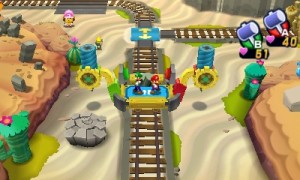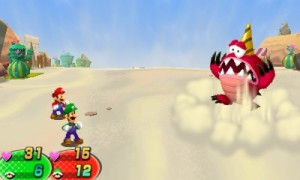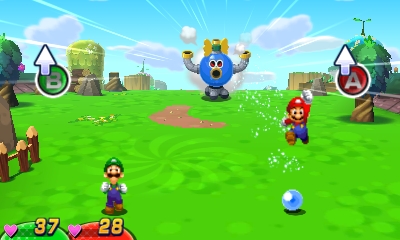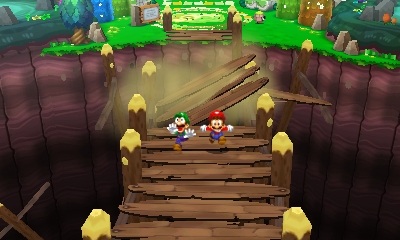Welcome to Pi’illo Island! Mario and Luigi: Dream Team Review
This game was reviewed on the Nintendo 3DS
Life can be a real grind, especially when you’re a renowned hero. Saving the world day in and day out can do a number on both your body and mind – even the best of us need time to rest and relax! And nobody knows this better than Princess Peach, so, when she receives an invitation to the resort on Pi’illo Island, it is only natural that she invites her hero, Mario, along with her. Oh, and his brother in green, of course! What’s his name again?
It’s not easy being the second banana. Luigi is forgotten by everyone, and it seems that nobody respects him except his big brother Mario, and Princess Peach. He’s not as talented as Mario, and not as experienced… he’s actually kind of a coward, and sleeps a lot of the time. It’s lucky for him that Pi’illo Island needs a hero who can sleep all day long, undisturbed by even the biggest disasters around him.
Brought to us by Nintendo, the story of Mario and Luigi: Dream Team is nothing unexpected for the Mario Brothers. Soon after arriving on Pi’illo Island, Princess Peach is kidnapped by a mysterious villain named Antasma, trapping her in the world of dreams. It is up to Mario to save the day, but he can’t do it without his brother’s help! With the incredible power to sleep really, really deeply, Luigi is able to use magic pillows to open up portals into his dreams. Through these portals, Mario is able to enter the dream world and search for his beloved Princess Peach. Things get complicated when Bowser arrives on the island, and strikes a deal with Antasma to use the power of dreams to take over the world.
 Mario and Luigi: Dream Team is a candy-coated treat for the eyes. Characters are rendered with large detailed 2D sprites that move and feel like the classic cartoon characters we know and love. This is especially true of the Mario Brothers themselves: they and the other major characters have very expressive faces and body language, and use pantomime and visual gags to communicate.
Mario and Luigi: Dream Team is a candy-coated treat for the eyes. Characters are rendered with large detailed 2D sprites that move and feel like the classic cartoon characters we know and love. This is especially true of the Mario Brothers themselves: they and the other major characters have very expressive faces and body language, and use pantomime and visual gags to communicate.
Backgrounds use simple shapes and are sharply defined. Everything is very bright and colourful, with generous applications of neon that are balanced by softer greens, greys, and blues, so that they don’t over-stimulate the eyes. Every scene pops visually because of the highlights and how thoughtfully the colours are contrasted with one another.
Stage and area layouts complement the Brothers’ movements: Pi’illo Island is full of platforms, levels and cliffs, so the Bros. will be jumping and bouncing and climbing all over it. As you progress, you open straight pathways that lead back to earlier areas, making travel quicker. Later still, you unlock a fast-travel system that lets you go directly to any area that you have previously visited. Traveling on Pi’illo Island is both fun and rewarding, with goodies scattered everywhere, and the shortcuts help in the few cases that you do need to backtrack.
 In Dream Team there are two worlds to explore: the waking world, and the dream world. The waking world has you playing in a top-down perspective as you run around vibrant spaces, leaping over platforms, hitting blocks, and smashing rocks with hammers. Throughout the game you learn special Bros. Attacks, which give Mario and Luigi new ways to explore. They can burrow into the ground, shrink to fit through narrow spaces, hover over huge chasms, and more. In both worlds you encounter friendly characters, shops, and enemy monsters while you play. Battles begin much like many RPGs, and are activated when you touch an enemy. You can even get a pre-emptive attack if you strike them with your hammer or jump on their head as you touch them!
In Dream Team there are two worlds to explore: the waking world, and the dream world. The waking world has you playing in a top-down perspective as you run around vibrant spaces, leaping over platforms, hitting blocks, and smashing rocks with hammers. Throughout the game you learn special Bros. Attacks, which give Mario and Luigi new ways to explore. They can burrow into the ground, shrink to fit through narrow spaces, hover over huge chasms, and more. In both worlds you encounter friendly characters, shops, and enemy monsters while you play. Battles begin much like many RPGs, and are activated when you touch an enemy. You can even get a pre-emptive attack if you strike them with your hammer or jump on their head as you touch them!
Battles occur on a different screen, with the Bros. at your left hand and the enemies at the right. You attack with jumps, hammers, and Bros. Attacks: if you time your moves right then you get a better rating, ranging from OK to EXCELLENT, and score extra damage on your foe. Every single enemy has its own unique attack patterns, with each type having between two to four different moves; sometimes they even swarm you all at once. Each enemy attack has a tell that reveals which Brother they will attack and suggest what you should do to counter-attack. Enemy and Bros. Attacks can take advantage of the 3D background, as you may face attacks from the distance when waves of enemies charge at you. You can also kick a shell into the distance, banking it off of enemies: each brother rallies the shell as they move ever-closer to the enemy, the shell bouncing faster and faster.
In the dream world, everything changes up. It is a side-scrolling platformer, with dreamy backgrounds. Mario travels here with Dreamy Luigi, Luigi’s ideal dream-self. Instead of using Bros. Attacks to overcome obstacles in the dream world, Luigi has the power to change shape and gain Luiginary powers, such as controlling time or temperature, or blowing hurricane winds. In dream world battles Luigi has fantastic abilities. His stats are added to Mario’s and he has no attacks of his own. Instead, whenever Mario strikes a foe, a host of Luigis appear to land a flurry of blows on the enemy horde. Luiginary attacks can be used in battle as well: a massive swarm of Luiginoids appear, and Mario must combine them into the shape of a massive hammer, a tower, or a rolling boulder that can crush all of the Bros.’ enemies.
The most fun that I had with Luiginary powers was during the Giant Luigi battles. For a select few boss fights, Dreamy Luigi becomes a titan, with Mario riding on his cap. During these battles you tilt the 3DS on its side, with Luigi on the touch screen and the boss on the 3D screen, the opponents standing tall and strong. Using touch controls, you can command Giant Luigi’s colossal power against these powerful enemies.
Outside of the battles the game offers a world that is fun and rewarding to explore. There are many mini-games and sidequests, with a ton of things to collect: attack pieces that give you new Bros. Attacks; beans that add to your stats; Pi’illos and expert challenges that reward you with rare and unique gear. Everything is really built around the battle system, which is very active and varied. It doesn’t feel like a typical turn-based RPG, and is more like a fighting game with its emphasis on action and reflexes.
At first, I didn’t really notice the music in Mario and Luigi: Dream Team. It blends in very well with the background, providing a distinct mood for each scene and the emotions of the characters, with enough variety that it didn’t stand out as repetitive – there are multiple battle themes and each environment in the waking and dream worlds has its own unique flavour. There is so much going on in this game that the music can slip almost unnoticed into the environment as an aural extension of the backdrops and colourful characters. But the more I listen to it, the more engrossed I am by the soundtrack.
Each track has that signature Mario feel to it: bouncy and peppy, even humorous tracks that sound like laughter, or the antics of clowns. It is a magnificent soundtrack for such a cartoony game as this, and it is a really deep and textured one as well. The battle themes reach the same dramatic heights as the best of the genre has to offer, and yet keeps the levity and high spirits of Super Mario’s world. The boss theme, “Never Let Up!” is one of the strongest tracks by far. It begins with a panicked introduction, capturing Mario and Luigi’s initial shock at their monstrous foe. There are rising horns that play just as players gain their bearings in the battle scene, and then dramatic strings signifying the Bros.’ resolve, pierced by the clash of cymbals just as the first blows are struck. The pace of this track and of many others matches the pace of gameplay perfectly, which actually adds to the game’s playability: the battles are rhythmic, with each attack requiring precise timing to pull off an excellent hit.
 The battle theme for dream world encounters, “Victory in the Dream World,” is another stand-out track. With hard percussion and manic synth it creates a dance hall for your thumbs, to rock out your enemies and rack up hits. When it hits its climax, “Victory in the Dream World” is an intense, multi-layered anticipation of your imminent success, and just after that ecstatic peak, the main theme of the Mario and Luigi series sneaks in for a few bars to slip you a wink and a nudge. This is music that believes in you, and knows that you can win.
The battle theme for dream world encounters, “Victory in the Dream World,” is another stand-out track. With hard percussion and manic synth it creates a dance hall for your thumbs, to rock out your enemies and rack up hits. When it hits its climax, “Victory in the Dream World” is an intense, multi-layered anticipation of your imminent success, and just after that ecstatic peak, the main theme of the Mario and Luigi series sneaks in for a few bars to slip you a wink and a nudge. This is music that believes in you, and knows that you can win.
Characteristic of the game as a whole is that it’s really, really funny. There are plenty of jokes and gags throughout; silly and ironic situations; goofy music; cartoon antics and pratfalls by the Brothers. Many characters have distinct, thick accents written into their dialogue: Monsieur Brock’s French accent, Boss Brickle’s New England accent, and the Massif Bros.’ wonderful, incredible Russian dialect. Mario and Luigi themselves are fully voice acted, holding deep and meaningful conversations in faux-Italian gibberish and speaking with exaggerated hand gestures. These quirks add to the increasing strangeness of the friends that you make on Pi’illo Island, peaking with the Massif Bros. These muscular, be-stached living statues, obsessed with bodybuilding and how beefy they are, act as your guides on the climb up Mount Pajamaja.
Even though there is no voice over, you can hear and feel the Massif Bros.’ stereotypical Russian accents oozing through the script: “You climb hard. Hard like muscle. You are tender cutlets. But climbing make strong! When we reach top, tender cutlets are: BEEF! STEAK! HUGE! HAMS!” I cannot stress enough how painfully funny this episode is. If the Massif Bros. are not sweaty and beefy enough men for your tastes, you will discover monuments dedicated to the Muscle Lords: testosterone-dripping hard bodies who performed legendary feats of buffness (sometimes even in the buff). I cried salty, marinating tears when the Massifs got to meet someone as beefy as their heroes. Is there anything finer or more beautiful than hero-worship?
 The biggest obstacle in Mario and Luigi: Dream Team is its overbearing tutorial. The game takes far too long to give any actual control over to players: after two hours of play, I was finally roaming freely around Pi’illo Island. The introduction to the game isn’t so egregious as far as RPGs go: the story is set up with scripted scenes and dialogue, and you don’t do much more than follow a straight path to the next scene. It’s really very standard in that regard. The issue is that this is also a Super Mario game, and not a typical RPG. Mario games typically open up with a playground area that lets players explore the controls and game mechanics with minimal direction. By contrast, Mario and Luigi: Dream Team takes the time to explain everything about its complex battle system up front. Sometimes you are given the option to skip a tutorial for a specific element of the game, but not everything can be skipped this way. It took me a full two hours before I was able to hop, run, and fight to my heart’s content.
The biggest obstacle in Mario and Luigi: Dream Team is its overbearing tutorial. The game takes far too long to give any actual control over to players: after two hours of play, I was finally roaming freely around Pi’illo Island. The introduction to the game isn’t so egregious as far as RPGs go: the story is set up with scripted scenes and dialogue, and you don’t do much more than follow a straight path to the next scene. It’s really very standard in that regard. The issue is that this is also a Super Mario game, and not a typical RPG. Mario games typically open up with a playground area that lets players explore the controls and game mechanics with minimal direction. By contrast, Mario and Luigi: Dream Team takes the time to explain everything about its complex battle system up front. Sometimes you are given the option to skip a tutorial for a specific element of the game, but not everything can be skipped this way. It took me a full two hours before I was able to hop, run, and fight to my heart’s content.
To say that the game explains everything up front would be an exaggeration. It explains a lot initially, but throughout the game you will learn new moves and attacks, and each time you are instructed that, if you want to, you can do a tutorial for that move. Do you want to? Are you sure you don’t want to? Okay, you can always check back later. To check it later, go to this part of the Menu. Got it? As you can clearly see it gets a little frustrating being constantly reminded you can go back to the tutorials at any time.
For experienced gamers (especially those familiar with this series), the tutorial can be overbearing and tedious, with the first dungeon really nothing more than a tutorial in disguise. Once you are free to explore the world the game becomes very easy to pick up and play. You can save your progress at any time, and can jump in for a few fun battles when you have time. The story is moved forward by silly characters with silly problems, and feels like you are playing through a cartoon. You can play in short bursts if you like, or in long stretches of time. The flow of the story is really up to you, as there are no natural breaks in the narrative that tell you to stop. There really is a lot to do, however you decide to play: after twenty hours of hammering away at the main storyline I was just over halfway through the game. I could sink another twenty hours into Pi’illo Island, soaking up the high energy battles and self-aware humour that saturates Mario and Luigi: Dream Team, and I’m sure gamers who give it a try will agree!
About This Post

